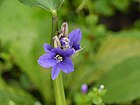Note: This is a project under development. The articles on this wiki are just being initiated and broadly incomplete. You can Help creating new pages.
Difference between revisions of "Monochoria vaginalis"
| Line 2: | Line 2: | ||
'''Monochoria vaginalis''' is a species of flowering plant in the water hyacinth family known by several common names, including heartshape false pickerelweed and oval-leafed pondweed. | '''Monochoria vaginalis''' is a species of flowering plant in the water hyacinth family known by several common names, including heartshape false pickerelweed and oval-leafed pondweed. | ||
==Uses== | ==Uses== | ||
| − | |||
==Parts Used== | ==Parts Used== | ||
| Line 8: | Line 7: | ||
==Chemical Composition== | ==Chemical Composition== | ||
| − | Monochoria vaginalis leaf and root extracts were evaluated for their antioxidant and anti-inflammatory property. | + | Monochoria vaginalis leaf and root extracts were evaluated for their antioxidant and anti-inflammatory property.<ref name="chemical composition"/> |
| − | <ref name="chemical composition"/> | ||
==Common names== | ==Common names== | ||
| − | {{Common names|kn=ನೀಲೋತ್ಪಲ | + | {{Common names|kn=ನೀಲೋತ್ಪಲ Neelotpala|ml=Kakkappola, Karinkuvalam, Kulachempu, Kuvalayam|sa=Indivara|ta=Karu-n-kuvalai|te=Neerukaacha, Nirokancha|hi=Nanka, Paanpatta |en=Oval Leaf Pondweed, Oval Leaf Monochoria}} |
==Properties== | ==Properties== | ||
| Line 35: | Line 33: | ||
==Identification== | ==Identification== | ||
===Leaf=== | ===Leaf=== | ||
| − | {{Leaf|Simple, heart-shaped or rounded, shiny, deep green in color| | + | {{Leaf|Simple, heart-shaped or rounded, shiny, deep green in color|Ovate-oblong to broadly ovate|Leaves variable - 2-12.5 cm long, 0.5-10 cm wide, in very young plants without lamina; leaves of somewhat older plants with a floating linear or lanceolate blade.}}<ref name="Leaf"/> |
===Flower=== | ===Flower=== | ||
| − | {{Flower|Bisexual||Petals six, violet or lilac blue|| | + | {{Flower|Bisexual||Petals six, violet or lilac blue||Spreading at flowering, afterwards spirally contorted. As is typical of many aquatic annuals, plant size, leaf shape}} |
===Other features=== | ===Other features=== | ||
| Line 49: | Line 47: | ||
==How to plant/cultivate== | ==How to plant/cultivate== | ||
| − | A plant of the moist tropics, where it is found at elevations up to 1,500 metres. It grows best in areas where annual daytime temperatures are within the range 22 - 35°c, but can tolerate 13 - 38°c. | + | A plant of the moist tropics, where it is found at elevations up to 1,500 metres. It grows best in areas where annual daytime temperatures are within the range 22 - 35°c, but can tolerate 13 - 38°c.<ref name="How to plant/cultivate"/> |
| − | <ref name="How to plant/cultivate"/> | ||
==Commonly seen growing in areas== | ==Commonly seen growing in areas== | ||
| Line 74: | Line 71: | ||
==External Links== | ==External Links== | ||
| − | * [https://en.wikipedia.org/wiki/Pontederia_vaginalis Monochoria vaginalis] | + | * [https://en.wikipedia.org/wiki/Pontederia_vaginalis Monochoria vaginalis on wikipedia.org] |
[[Category:Herbs]] | [[Category:Herbs]] | ||
[[Category:Pontederiaceae]] | [[Category:Pontederiaceae]] | ||
Latest revision as of 15:35, 24 June 2020
Monochoria vaginalis is a species of flowering plant in the water hyacinth family known by several common names, including heartshape false pickerelweed and oval-leafed pondweed.
Contents
- 1 Uses
- 2 Parts Used
- 3 Chemical Composition
- 4 Common names
- 5 Properties
- 6 Habit
- 7 Identification
- 8 List of Ayurvedic medicine in which the herb is used
- 9 Where to get the saplings
- 10 Mode of Propagation
- 11 How to plant/cultivate
- 12 Commonly seen growing in areas
- 13 Photo Gallery
- 14 References
- 15 External Links
Uses
Parts Used
Chemical Composition
Monochoria vaginalis leaf and root extracts were evaluated for their antioxidant and anti-inflammatory property.[1]
Common names
| Language | Common name |
|---|---|
| Kannada | ನೀಲೋತ್ಪಲ Neelotpala |
| Hindi | Nanka, Paanpatta |
| Malayalam | Kakkappola, Karinkuvalam, Kulachempu, Kuvalayam |
| Tamil | Karu-n-kuvalai |
| Telugu | Neerukaacha, Nirokancha |
| Marathi | NA |
| Gujarathi | NA |
| Punjabi | NA |
| Kashmiri | NA |
| Sanskrit | Indivara |
| English | Oval Leaf Pondweed, Oval Leaf Monochoria |
Properties
Reference: Dravya - Substance, Rasa - Taste, Guna - Qualities, Veerya - Potency, Vipaka - Post-digesion effect, Karma - Pharmacological activity, Prabhava - Therepeutics.
Dravya
Rasa
Guna
Veerya
Vipaka
Karma
Prabhava
Habit
Identification
Leaf
| Kind | Shape | Feature |
|---|---|---|
| Simple, heart-shaped or rounded, shiny, deep green in color | Ovate-oblong to broadly ovate | Leaves variable - 2-12.5 cm long, 0.5-10 cm wide, in very young plants without lamina; leaves of somewhat older plants with a floating linear or lanceolate blade. |
Flower
| Type | Size | Color and composition | Stamen | More information |
|---|---|---|---|---|
| Bisexual | Petals six, violet or lilac blue | Spreading at flowering, afterwards spirally contorted. As is typical of many aquatic annuals, plant size, leaf shape |
Other features
List of Ayurvedic medicine in which the herb is used
Where to get the saplings
Mode of Propagation
How to plant/cultivate
A plant of the moist tropics, where it is found at elevations up to 1,500 metres. It grows best in areas where annual daytime temperatures are within the range 22 - 35°c, but can tolerate 13 - 38°c.[3]
Commonly seen growing in areas
Photo Gallery
References
External Links
- Herbs with Roots used in medicine
- Herbs with Leaves used in medicine
- Herbs with common name in Kannada
- Herbs with common name in Hindi
- Herbs with common name in Malayalam
- Herbs with common name in Tamil
- Herbs with common name in Telugu
- Herbs with common name in Sanskrit
- Herbs with common name in English
- Habit - Herbs
- Index of Plants which can be propagated by Seeds
- Herbs that are commonly seen in the region of Lowland forest
- Herbs
- Pontederiaceae



